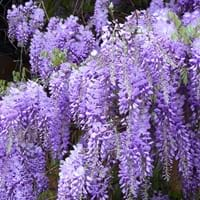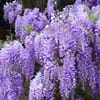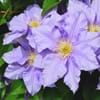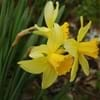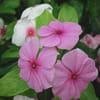Life Span
Perennial
Annual and Perennial
Type
Flowering Plants
Tender Perennial
Origin
China, Eastern United States, Japan, Korea
South Africa
Types
Chinese Wisteria, Japanese wisteria, Silky wisteria, American wisteria
Osteospermum acanthospermum, Osteospermum amplectens, Osteospermum burttianum
Habitat
Forest edges, River side
Coastal Regions, Sandy areas, Terrestrial
USDA Hardiness Zone
5-9
10-11
AHS Heat Zone
8-1
Not Available
Sunset Zone
2a, 2b, 3a, 3b, 4, 5, 6, 7, 8, 9, 10, 11, 13, 14, 15, 16, 17, 18, 19, 20, 21, 22, 23, 24
8, 9, 12, 13, 14, 15, 16, 17, 18, 19, 20, 21, 22, 23, 24
Habit
Vine/Liana
Clump-Forming
Flower Color
Pink, Purple, Violet
White, Purple, Blue Violet
Flower Color Modifier
Not Available
Bicolor
Fruit Color
Not Available
Not Available
Leaf Color in Spring
Green
Green
Leaf Color in Summer
Green
Green
Leaf Color in Fall
Green
Green, Blue Green
Leaf Color in Winter
Not Available
Light Green
Leaf Shape
Ovate
Irregular
Plant Season
Spring
Spring, Summer, Fall
Sunlight
Full Sun
Full Sun, Partial Sun
Type of Soil
Clay, Loamy, Sandy
Loam
The pH of Soil
Neutral, Slightly Acidic, Slightly Alkaline
Neutral
Soil Drainage
Well drained
Well drained
Bloom Time
Mid Spring
Late Spring, Early Summer, Summer, Late Summer, Early Fall, Fall
Tolerances
Not Available
Drought
Where to Plant?
Ground, Pot
Container
How to Plant?
Seedlings
Seedlings, Stem Cutting
Plant Maintenance
Medium
Medium
Watering Requirements
Water in morning to avoid prompting diseases, when new, water every week
Do Not over Water, Keep ground moist
In Summer
Lots of watering
Lots of watering
In Spring
Moderate
Moderate
In Winter
Average Water
Average Water
Soil pH
Neutral, Slightly Acidic, Slightly Alkaline
Neutral
Soil Type
Clay, Loamy, Sandy
Loam
Soil Drainage Capacity
Well drained
Well drained
Sun Exposure
Full Sun
Full Sun, Partial Sun
Pruning
Cut or pinch the stems, No pruning needed in the early stages, Prune twice a year, Remove dead or diseased plant parts, Remove deadheads
Remove damaged leaves, Remove dead branches, Remove dead leaves
Fertilizers
All-Purpose Liquid Fertilizer
All-Purpose Liquid Fertilizer
Pests and Diseases
Aphids, Canker, Crown gall, Leaf spot, Mealybugs, Powdery mildew, Root rot, Scale
Red blotch
Plant Tolerance
Drought
Drought
Flower Petal Number
Single
Single
Foliage Texture
Coarse
Medium
Foliage Sheen
Not Available
Not Available
Attracts
Flying insects
Bees, Birds, Butterflies
Allergy
Itchiness
Not Available
Aesthetic Uses
Showy Purposes
Beautification, Showy Purposes
Beauty Benefits
Not Available
Not Available
Environmental Uses
Air purification
Air purification
Medicinal Uses
Not Available
Not Applicable
Part of Plant Used
Flowers, Seeds
Flowers
Other Uses
Sometimes used for making wine
Used as Ornamental plant
Used As Indoor Plant
No
No
Used As Outdoor Plant
Yes
Yes
Garden Design
Shady Tree, Showy Tree, Street Trees
Bedding Plant, Container, Cutflower, Foundation, Groundcover, Hanging Basket, Mixed Border, Rock Garden / Wall
Botanical Name
Wisteria
OSTEOSPERMUM fruticosum
Common Name
Wisteria
Shrubby Daisybush, Trailing African Daisy
In Hindi
Wisteria
Blue Eyed Daisy Plant
In German
Glyzinien
Blue Eyed Daisy Pflanze
In French
Glycines
Blue Eyed Daisy Plante
In Spanish
Glicinas
Planta observada azul de la margarita
In Greek
γλυκίνη
Μπλε Eyed Daisy Φυτών
In Portuguese
Glicínias
Planta da margarida de olhos azuis
In Polish
Wisteria
Blue Eyed Daisy roślin
In Latin
Wisteria
Daisy Blue Eyed Planta
Phylum
Anthophyta
Magnoliophyta
Class
Dicotyledonae
Magnoliopsida
Family
Fabaceae
Asteraceae
Genus
Wisteria
Osteospermum
Clade
Not Available
Angiosperms, Asterids, Eudicots
Tribe
Millettieae
Calenduleae
Subfamily
Faboideae
Asteroideae
Season and Care of Wisteria and Blue Eyed Daisy Plant
Season and care of Wisteria and Blue Eyed Daisy Plant is important to know. While considering everything about Wisteria and Blue Eyed Daisy Plant Care, growing season is an essential factor. Wisteria season is Spring and Blue Eyed Daisy Plant season is Spring. The type of soil for Wisteria is Clay, Loamy, Sandy and for Blue Eyed Daisy Plant is Loam while the PH of soil for Wisteria is Neutral, Slightly Acidic, Slightly Alkaline and for Blue Eyed Daisy Plant is Neutral.
Wisteria and Blue Eyed Daisy Plant Physical Information
Wisteria and Blue Eyed Daisy Plant physical information is very important for comparison. Wisteria height is 10.00 cm and width 30.00 cm whereas Blue Eyed Daisy Plant height is 36.00 cm and width 51.00 cm. The color specification of Wisteria and Blue Eyed Daisy Plant are as follows:
Wisteria flower color: Pink, Purple and Violet
Wisteria leaf color: Green
Blue Eyed Daisy Plant flower color: White, Purple and Blue Violet
- Blue Eyed Daisy Plant leaf color: Green
Care of Wisteria and Blue Eyed Daisy Plant
Care of Wisteria and Blue Eyed Daisy Plant include pruning, fertilizers, watering etc. Wisteria pruning is done Cut or pinch the stems, No pruning needed in the early stages, Prune twice a year, Remove dead or diseased plant parts and Remove deadheads and Blue Eyed Daisy Plant pruning is done Remove damaged leaves, Remove dead branches and Remove dead leaves. In summer Wisteria needs Lots of watering and in winter, it needs Average Water. Whereas, in summer Blue Eyed Daisy Plant needs Lots of watering and in winter, it needs Average Water.
